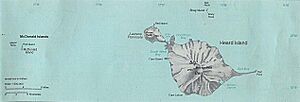List of birds of Heard and McDonald Islands facts for kids
Welcome to the amazing world of birds found on Heard Island and McDonald Islands! These islands are tiny pieces of land in the big Southern Ocean. They are part of Australia, even though they are far away. Most of the birds here are seabirds. This means they spend most of their lives at sea, finding their food in the ocean.
There are 47 different kinds of birds that visit or live on these islands. One of them is found nowhere else in the world! We will learn about these birds, from tiny storm-petrels to huge albatrosses. We also use a special list called The Clements Checklist of Birds of the World to make sure we use the correct names for all the birds.
Some birds here are special. For example, the black-faced sheathbill is the only bird that lives and breeds only on land here. It's a scavenger, meaning it eats leftover food around seal and penguin groups. Other birds like the southern giant-petrel and Subantarctic skua also scavenge, but they can also hunt other birds.
Heard Island is a very important place for penguins to have their babies. Many different kinds of penguins live here, like the macaroni, eastern rockhopper, gentoo, and king penguins. The Heard shag and the black-faced sheathbill are endemic to these islands. This means they are found only here and nowhere else!
The waters around the islands are home to many albatrosses and petrels. Some of these birds also breed on the islands. Sadly, some, like the southern giant-petrel and the wandering albatross, are in danger. They are sometimes caught by accident in fishing nets, especially during long-line fishing.
You will see some letters next to the bird names. Here is what they mean:
- (A) Accidental - This bird rarely visits Heard and McDonald Islands. It's like a surprise visitor!
- (E) Endemic - This bird is found only on Heard and McDonald Islands. It's unique to this place!
Birds of Heard Island and McDonald Islands
Sheathbills: Land Scavengers
Sheathbills are unique birds that live in the Antarctic regions. They are mostly white and look a bit like plump doves. They are known for being scavengers, meaning they eat leftover food.
- Black-faced sheathbill, Chionis minor
Skuas and Jaegers: Ocean Hunters
Skuas are medium to large birds. They usually have grey or brown feathers. They build their nests on the ground in cooler parts of the world. Many skuas travel long distances. They are known to hunt other birds and also scavenge for food.
- South polar skua, Stercorarius maccormicki (A)
- Brown skua, Stercorarius antarctica
Gulls, Terns, and Skimmers: Coastal Birds
This group includes gulls and terns. Gulls are usually grey or white with black marks. They have strong bills and webbed feet. Terns are also often grey or white, but they usually have black marks on their heads. Most terns dive into the water to catch fish. Some also eat insects from the water's surface. Terns can live for a very long time, sometimes over 30 years!
- Kelp gull, Larus dominicanus
- Arctic tern, Sterna paradisaea
- Antarctic tern, Sterna vittata
Penguins: Flightless Swimmers
Penguins are amazing birds that cannot fly. They live mostly in the Southern Hemisphere. They are excellent swimmers and catch their food underwater. They eat small sea creatures like krill, fish, and squid.
- King penguin, Aptenodytes patagonicus
- Emperor penguin, Aptenodytes forsteri
- Adelie penguin, Pygoscelis adeliae
- Gentoo penguin, Pygoscelis papua
- Chinstrap penguin, Pygoscelis antarctica
- Macaroni penguin, Eudyptes chrysolophus
- Southern rockhopper penguin, Eudyptes chrysocome
Albatrosses: Giants of the Sky
Albatrosses are some of the biggest flying birds in the world. Some types, like the great albatrosses, have the largest wingspans of any living bird. They can glide for very long distances over the ocean.
- Yellow-nosed albatross, Thalassarche chlororhynchos (A)
- Gray-headed albatross, Thalassarche chrysostoma (A)
- Black-browed albatross, Thalassarche melanophris
- Sooty albatross, Phoebetria fusca (A)
- Light-mantled albatross, Phoebetria palpebrata
- Royal albatross, Diomedea epomophora (A)
- Wandering albatross, Diomedea exulans
Southern Storm-Petrels: Tiny Ocean Flyers
Southern storm-petrels are related to petrels. They are the smallest seabirds you will find. They eat tiny sea creatures called plankton and small fish. They pick their food from the water's surface while hovering. Their flight can look like a bat's.
- Wilson's storm-petrel, Oceanites oceanicus
- Gray-backed storm-petrel, Garrodia nereis
- Black-bellied storm-petrel, Fregetta tropica (A)
Shearwaters and Petrels: Diverse Ocean Birds
This is a large group of medium-sized "true petrels." They have special nostrils and a long outer wing feather. They are very common seabirds found across the oceans.
- Southern giant-petrel, Macronectes giganteus
- Northern giant-petrel, Macronectes halli (A)
- Southern fulmar, Fulmarus glacialoides
- Antarctic petrel, Thalassoica antarctica
- Cape petrel, Daption capense
- Snow petrel, Pagodroma nivea
- Kerguelen petrel, Aphrodroma brevirostris (A)
- Soft-plumaged petrel, Pterodroma mollis (A)
- White-headed petrel, Pterodroma lessonii (A)
- Mottled petrel, Pterodroma inexpectata (A)
- Blue petrel, Halobaena caerulea (A)
- Fairy prion, Pachyptila turtur
- Broad-billed prion, Pachyptila vittata (A)
- Salvin's prion, Pachyptila salvini
- Antarctic prion, Pachyptila desolata
- Slender-billed prion, Pachyptila belcheri (A)
- Fulmar prion, Pachyptila crassirostris
- Gray petrel, Procellaria cinerea (A)
- White-chinned petrel, Procellaria aequinoctialis (A)
- Sooty shearwater, Ardenna grisea
- Common diving-petrel, Pelecanoides urinatrix
- South Georgia diving-petrel, Pelecanoides georgicus
colend}}
Cormorants and Shags: Fish Eaters
This family includes cormorants and shags. They are medium to large seabirds that live near coasts. They are excellent at catching fish. Most of them have dark feathers, but some can be black and white or even colorful.
- Imperial cormorant, Leucocarbo atriceps
- Heard Island shag, Leucocarbo nivalis (E)
More to Explore
- Heard and McDonald Islands Important Bird Area
- List of birds
- Lists of birds by region


